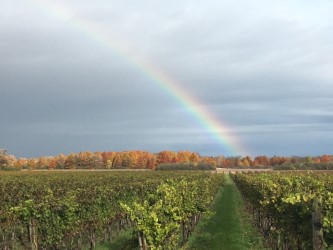Now that the last of the Cabernet Sauvignon is finally in barrel, it’s time to take a relaxing look back at the complex 2018 Vintage. Legitimate attempts are made to positively reminisce, only to get bogged down each time with flashbacks to rainy days and rotten fruit. It turns out that there will be nothing “relaxing” about this exercise after all!
I will never take a dry October for granted again. It becomes apparent, in a year such as this, how extremely fortunate we are as winemakers when late fall conditions are either dry or warm or both. We come to accept that early harvest weather is nearly always variable due to August and September heat and thunderstorm threats, but in recent years we’ve been treated to glorious October and November days that were perfect for ripening Cabernet Sauvignon and Syrah. This was certainly not the case in 2018! However, do not despair Cab lovers, the last month of hang time does not tell the whole story of 2018 – making it a truly one of a kind and intriguing vintage.
After a normal budbreak date and good initial bud survival rates, the vines took off and never slowed down. Continued lush growth, even through a very dry season, illustrated how important the rainy year of 2017 was to replenish the water table for deep-rooted, old vines. In fact, 2017 and 2018 would prove to be polar opposite vintages from a climate pattern standpoint, which should make for some interesting comparative tastings in the future.
As the summer progressed, wary farmers would shy away from predicting just how good the season was shaping up to be, perhaps because they could sense an eventual turn for the worse. I’ve learned the hard way to trust the intuition of wise old farmers…and only hope that I can become one someday.
A very hot, humid stretch in late August brought about a rapid transition through veraison and left winemakers drooling at the possibilities. Negatively, it also ramped up disease pressure from both botrytis and Grape Berry Moth, creating breakdown chaos all over the peninsula. All the early varietals were ready to pick at once – and two weeks early at that!
It was setting up to be an easy glide into the later varietals, when the aforementioned rains innocently started to fall. What followed was a miserable cycle of vineyard work, fruit sampling, cursing, thinning clusters, sampling again and more cursing. It took much perseverance and the continued ruthless thinning of rotten berries to salvage any kind of quality crop.
As a grape grower, it was a minor victory just to have all of your fruit accepted by wineries in 2018. The predominant post-harvest feeling among winemakers was that the early varietals showed much promise, but achieving peak phenolic ripeness in the later stuff (Cab Sauv, Merlot, Cab Franc) was hit and miss depending on the vineyard. My hope is that the summer heat, combined with the late season grunt work, was enough to produce a Cabernet Sauvignon worthy of a Five Rows handwritten label.
Perspective is understandably clouded in the aftermath of a challenging vintage, but my years in this industry have taught me that time will soften my feelings about 2018, just like time in barrel will soften the wines.

